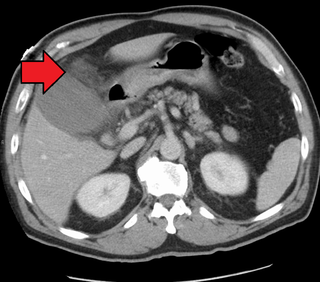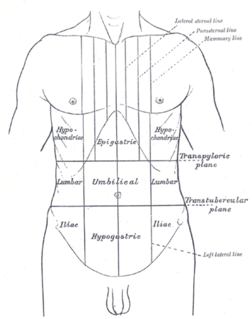Related Research Articles

Appendicitis is inflammation of the appendix. Symptoms commonly include right lower abdominal pain, nausea, vomiting, and decreased appetite. However, approximately 40% of people do not have these typical symptoms. Severe complications of a ruptured appendix include widespread, painful inflammation of the inner lining of the abdominal wall and sepsis.

Peritonitis is inflammation of the peritoneum, the lining of the inner wall of the abdomen and cover of the abdominal organs. Symptoms may include severe pain, swelling of the abdomen, fever, or weight loss. One part or the entire abdomen may be tender. Complications may include shock and acute respiratory distress syndrome.

An appendectomy, also termed appendicectomy, is a surgical operation in which the vermiform appendix is removed. Appendectomy is normally performed as an urgent or emergency procedure to treat complicated acute appendicitis.

Cholecystitis is inflammation of the gallbladder. Symptoms include right upper abdominal pain, nausea, vomiting, and occasionally fever. Often gallbladder attacks precede acute cholecystitis. The pain lasts longer in cholecystitis than in a typical gallbladder attack. Without appropriate treatment, recurrent episodes of cholecystitis are common. Complications of acute cholecystitis include gallstone pancreatitis, common bile duct stones, or inflammation of the common bile duct.

McBurney's point is the name given to the point over the right side of the abdomen that is one-third of the distance from the anterior superior iliac spine to the umbilicus (navel). This point roughly corresponds to the most common location of the base of the appendix where it is attached to the cecum.

Laryngitis is inflammation of the larynx. Symptoms often include a hoarse voice and may include fever, cough, pain in the front of the neck, and trouble swallowing. Typically, these last under two weeks.

Abdominal pain, also known as a stomach ache, is a symptom associated with both non-serious and serious medical issues.

A Meckel's diverticulum, a true congenital diverticulum, is a slight bulge in the small intestine present at birth and a vestigial remnant of the omphalomesenteric duct. It is the most common malformation of the gastrointestinal tract and is present in approximately 2% of the population, with males more frequently experiencing symptoms.
Blumberg's sign is a clinical sign in which there is pain upon removal of pressure rather than application of pressure to the abdomen. It is indicative of peritonitis. It was named after German surgeon Jacob Moritz Blumberg.
The psoas sign, also known as Cope's psoas test or Obraztsova's sign, is a medical sign that indicates irritation to the iliopsoas group of hip flexors in the abdomen, and consequently indicates that the inflamed appendix is retrocaecal in orientation.
Yersiniosis is an infectious disease caused by a bacterium of the genus Yersinia. In the United States, most yersiniosis infections among humans are caused by Yersinia enterocolitica.
In medicine, Valentino's syndrome is pain presenting in the right lower quadrant of the abdomen caused by a duodenal ulcer with perforation through the retroperitoneum.

The obturator sign or Cope's obturator test is an indicator of irritation to the obturator internus muscle.

Paul Georges Dieulafoy was a French physician and surgeon. He is best known for his study of acute appendicitis and his description of Dieulafoy's lesion, a rare cause of gastric bleeding.

Epiploic appendagitis (EA) is an uncommon, benign, self-limiting inflammatory process of the epiploic appendices. Other, older terms for the process include appendicitis epiploica and appendagitis, but these terms are used less now in order to avoid confusion with acute appendicitis.
Abdominal guarding is the tensing of the abdominal wall muscles to guard inflamed organs within the abdomen from the pain of pressure upon them. The tensing is detected when the abdominal wall is pressed. Abdominal guarding is also known as 'défense musculaire'.

The abdominopelvic cavity is a body cavity that consists of the abdominal cavity and the pelvic cavity. It contains the stomach, liver, pancreas, spleen, gallbladder, kidneys, and most of the small and large intestines. It also contains the urinary bladder and internal reproductive organs. The abdominal pelvic cavity is a little pocket sac that lies way low in the base of the abdominal pelvis cavity. There's no membrane that separates out the abdominal cavity from the pelvic cavity so it is sometimes referred to as the abdominal pelvis or the peritoneal cavity. There are many diseases and disorders associated with the organs of the abdominopelvic cavity.
In medicine, Carnett's sign is a finding on clinical examination in which (acute) abdominal pain remains unchanged or increases when the muscles of the abdominal wall are tensed. For this part of the abdominal examination, the patient can be asked to lift the head and shoulders from the examination table to tense the abdominal muscles. An alternative is to ask the patient to raise both legs with straight knees.

A symptom is a departure from normal function or feeling which is apparent to a patient, reflecting the presence of an unusual state, or of a disease. A symptom can be subjective or objective. Tiredness is a subjective symptom whereas cough or fever are objective symptoms. In contrast to a symptom, a sign is a clue to a disease elicited by an examiner or a doctor. For example, paresthesia is a symptom, whereas erythema is a sign. Symptoms and signs are often nonspecific, but often combinations of them are at least suggestive of certain diagnoses, helping to narrow down what may be wrong. In other cases they are specific even to the point of being pathognomonic.
The Markle sign or jar tenderness is a clinical sign in which pain in the right lower quadrant of the abdomen is elicited by dropping from standing on the toes to the heels with a jarring landing. It is found in patients with localised peritonitis due to acute appendicitis. It is similar to rebound tenderness, but may be easier to elicit when the patient has firm abdominal wall muscles. Abdominal pain on walking or running is an equivalent sign.
References
- ↑ Sachdeva, Anupam; Dutta, AK (31 August 2012). Advances in Pediatrics. JP Medical Ltd. p. 1432. ISBN 978-93-5025-777-7.
- ↑ Diagnosis and Treatment of Acute Appendicitis JMAJ 46(5): 217–221, 2003 Hiroshi ISHIKAWA
- ↑ http://surgerylp.blog.net.ua/